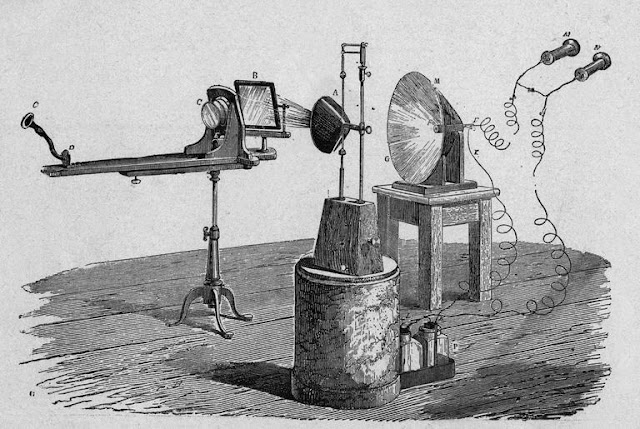Alexander Graham Bell's Photophone Was An Invention Ahead of Its Time
While the telephone used electricity, the photophone used light
While he's best known as the inventor of the telephone, Alexander Graham Bell considered the photophone his most important invention... and he may have been right.
On June 3, 1880, Alexander Graham Bell transmitted the first wireless telephone message on his newly invented "photophone," a device that allowed for the transmission of sound on a beam of light. Bell held four four patents for the photophone, and built it with the help of an assistant, Charles Sumner Tainter.
The first wireless voice transmission took place over a distance of 700 feet.
Bell's photophone worked by projecting voice through an instrument toward a mirror. Vibrations in the voice caused oscillations in the shape of the mirror. Bell directed sunlight into the mirror, which captured and projected the mirror's oscillations toward a receiving mirror, where the signals were transformed back into sound at the receiving end of the projection. The photophone functioned similarly to the telephone, except the photophone used light as a means of projecting the information, while the telephone relied on electricity.
The photophone was the first wireless communications device, preceding the invention of the radio by nearly 20 years.
Although the photophone was an extremely important invention, the significance of Bell's work was not fully recognized in its time. This was largely due to practical limitations in the technology of the time: Bell's original photophone failed to protect transmissions from outside interferences, such as clouds, that easily disrupted transport.
That changed nearly a century later when the invention of fiber optics in the 1970s allowed for the secure transport of light. Indeed, Bell's photophone is recognized as the progenitor of the modern fiber optic telecommunications system that is widely used to transmit telephone, cable, and internet signals across large distances.
On June 3, 1880, Alexander Graham Bell transmitted the first wireless telephone message on his newly invented "photophone," a device that allowed for the transmission of sound on a beam of light. Bell held four four patents for the photophone, and built it with the help of an assistant, Charles Sumner Tainter.
The first wireless voice transmission took place over a distance of 700 feet.
Bell's photophone worked by projecting voice through an instrument toward a mirror. Vibrations in the voice caused oscillations in the shape of the mirror. Bell directed sunlight into the mirror, which captured and projected the mirror's oscillations toward a receiving mirror, where the signals were transformed back into sound at the receiving end of the projection. The photophone functioned similarly to the telephone, except the photophone used light as a means of projecting the information, while the telephone relied on electricity.
The photophone was the first wireless communications device, preceding the invention of the radio by nearly 20 years.
Although the photophone was an extremely important invention, the significance of Bell's work was not fully recognized in its time. This was largely due to practical limitations in the technology of the time: Bell's original photophone failed to protect transmissions from outside interferences, such as clouds, that easily disrupted transport.
That changed nearly a century later when the invention of fiber optics in the 1970s allowed for the secure transport of light. Indeed, Bell's photophone is recognized as the progenitor of the modern fiber optic telecommunications system that is widely used to transmit telephone, cable, and internet signals across large distances.
Posted By ZaptaiLo.BlogSpot.Com









Post a Comment